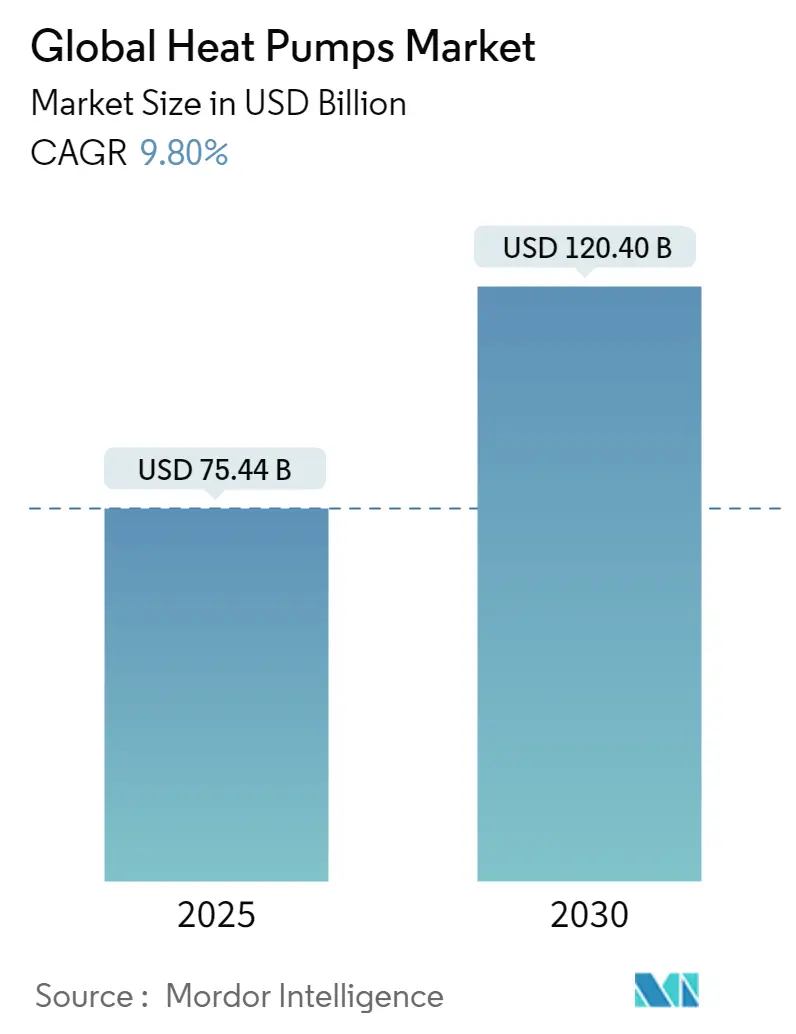
| Study Period | 2019 - 2030 |
| Market Size (2025) | USD 75.44 Billion |
| Market Size (2030) | USD 120.40 Billion |
| CAGR (2025 - 2030) | 9.80 % |
| Fastest Growing Market | Europe |
| Largest Market | Asia Pacific |
| Market Concentration | Low |
Major Players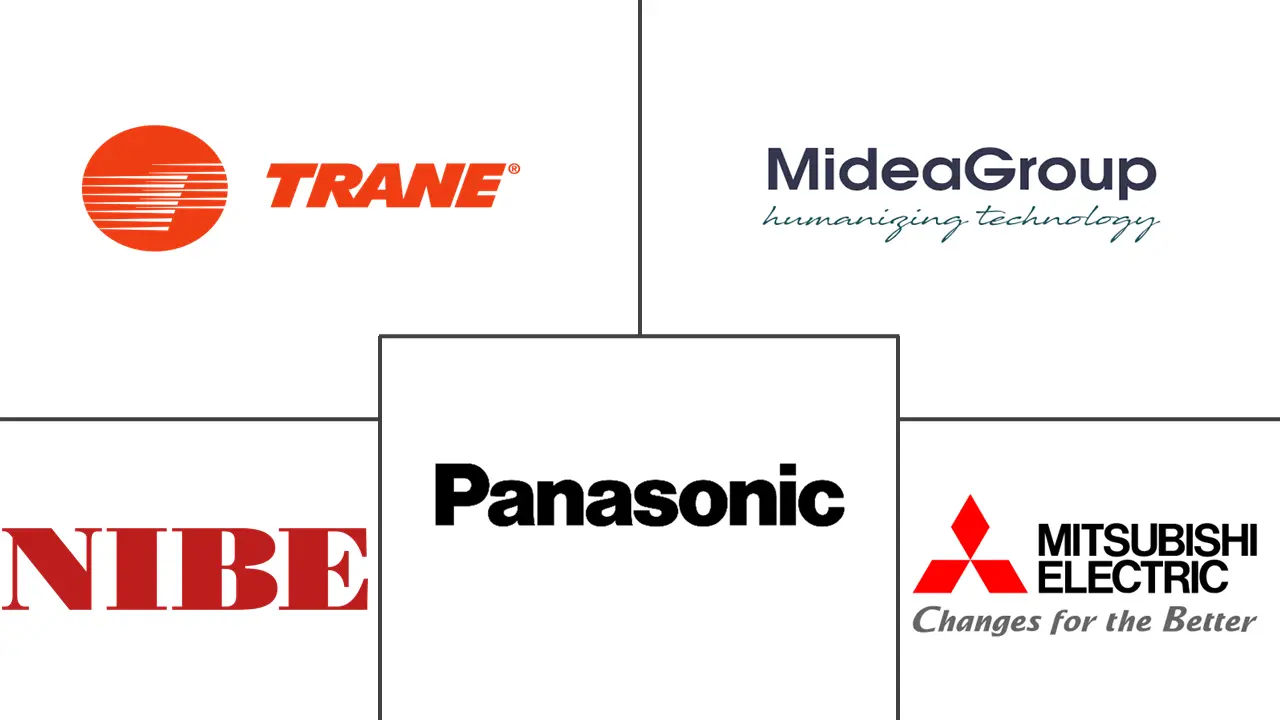
*Disclaimer: Major Players sorted in no particular order |
Heat Pump Market Analysis
The Global Heat Pumps Market size is estimated at USD 75.44 billion in 2025, and is expected to reach USD 120.40 billion by 2030, at a CAGR of 9.8% during the forecast period (2025-2030).
The heat pump industry is experiencing a transformative shift driven by global energy security concerns and technological advancements. According to the International Energy Agency (IEA), heat pumps currently meet only around 10% of global heating needs in buildings, with projections indicating potential coverage of up to 20% of annual heating requirements by 2030. This transition is particularly evident in mature markets like Japan, where approximately 90% of households have already adopted heat pump air conditioning systems, setting a benchmark for other regions to follow. The industry's evolution is further characterized by significant technological improvements in efficiency and performance, enabling heat pumps to operate effectively even in extreme weather conditions.
The commercial building sector is witnessing a substantial transformation in heating and cooling systems adoption. The European Union's sector integration strategy projects that 65% of all commercial buildings will be heated by electricity by 2030, representing a significant shift from traditional heating methods. This transition is supported by recent regulatory changes, such as the Washington State Building Code Council's mandate effective July 2023, requiring new commercial buildings to use heat pumps for heating their water and interior spaces. These developments are reshaping building design and energy infrastructure planning across major markets.
The industry is experiencing rapid innovation and investment in research and development, particularly in improving system efficiency and reducing installation complexity. Heat pump systems now demonstrate remarkable efficiency gains, offering energy savings of 25-50% compared to conventional heating and cooling systems. This efficiency improvement is coupled with advances in smart control systems and integration capabilities with renewable energy sources, making heat pumps increasingly attractive for both new construction and retrofit applications.
The heat pump market is witnessing significant policy-driven transformations across different regions. In 2023, the Netherlands announced plans to mandate hybrid heat pump systems from 2026, while the United Kingdom allocated GBP 15 million in funding for innovation projects aimed at making heat pumps more affordable and easier to install. These policy initiatives are complemented by industry commitments, such as Daikin's support for the REPowerEU initiative, which aims to increase heat pump installations from 10 million to 30 million units by 2030. This combination of policy support and industry investment is creating a robust foundation for sustained heat pump market growth and technological advancement.
Heat Pump Market Trends
Increasing Demand for Energy Efficient Solutions
The growing demand for energy-efficient devices has been driving significant adoption of heat pump technology, as these systems can provide space heating, cooling, and warm water from a single integrated unit. Heat pumps demonstrate remarkable efficiency, operating at 350%-450% efficiency by producing 3.5-4.5 units of energy in heat for every unit they consume, making them substantially more efficient than conventional heating systems. According to the Heat Pump & Thermal Storage Technology Center of Japan, heat pumps are up to 10 times more energy efficient than combustion-based systems, which has helped Japan achieve one of the highest energy conservation standards globally. This exceptional efficiency has made heat pumps particularly attractive for both residential and commercial heat pump market applications, where they can reduce heating costs by up to 25% compared to traditional gas boilers.
The integration of heat pumps with renewable energy sources has further enhanced their appeal as energy-efficient solutions. For instance, in Japan, companies like Panasonic have developed innovative systems combining solar panels with heat pumps to optimize solar power output and provide stable energy generation for homes. The United States Department of Energy reports that when properly installed, air-source heat pumps can deliver up to three times more heat energy to a home than the electrical energy they consume, as they transfer heat rather than convert it from fuel like combustion heating systems. This efficiency advantage has led to increased adoption in various applications, from single-family homes to large commercial heat pump market buildings, where heat pumps can effectively manage different heating and cooling needs simultaneously, eliminating the need for expensive 3- or 4-pipe HVAC systems.
Increasing Government Initiatives to Curb Carbon Emissions
Governments worldwide are implementing aggressive policies and initiatives to reduce carbon emissions, with heat pumps playing a central role in their decarbonization strategies. South Korea has set an ambitious target of a 40% reduction in greenhouse gas emissions by 2030, while Australia aims to reduce emissions by 26-28% from 2005 levels by 2030. The European Union's building stock is responsible for approximately 36% of all CO2 emissions, prompting initiatives like REPowerEU, which aims to boost heat pump market trends from 10 million units in 2027 to 30 million units by 2030. These targets are supported by substantial financial incentives, such as the UK government's £15 million funding program launched in 2023 to make heat pumps more affordable and easier to install, complementing their existing £450 million Boiler Upgrade Scheme.
The regulatory landscape continues to evolve with new mandates and building codes supporting heat pump adoption. The California Energy Commission's 2023 Building Energy Efficiency Standards now require new single-family homes to have electric heat pumps for water and air, while all new multi-family residences must include electric heat pumps for space heating. In Europe, countries like France have taken decisive action by eliminating subsidies for fossil fuel heating installations while increasing support for renewable heat pump systems. The Netherlands has announced mandatory installation of hybrid heat pump systems starting in 2026, expecting to reduce heating costs while preventing the use of fossil fuels. These initiatives are complemented by significant investments, such as Germany's €2.98 billion plan approved in 2023 to develop green district heating based on renewable energy and waste heat, which includes substantial support for heat pump installations, reflecting a comprehensive heat pump market analysis.
Segment Analysis: By Type
Air-source Segment in Global Heat Pumps Market
The air-source segment dominates the global heat pump market, commanding approximately 80% market share in 2024. This significant market position is driven by several key advantages, including lower installation costs compared to other variants and versatility in both heating and cooling applications. Air-source heat pumps have proven particularly effective in residential applications, where they can deliver up to three times more heat energy to homes than the electrical energy they consume. The segment's strong performance is further supported by technological advancements that have improved their efficiency in colder climates, making them viable alternatives even in regions experiencing extended periods of subfreezing temperatures. Additionally, the segment benefits from various government initiatives and incentives promoting the adoption of air-source heat pumps as part of broader decarbonization efforts.
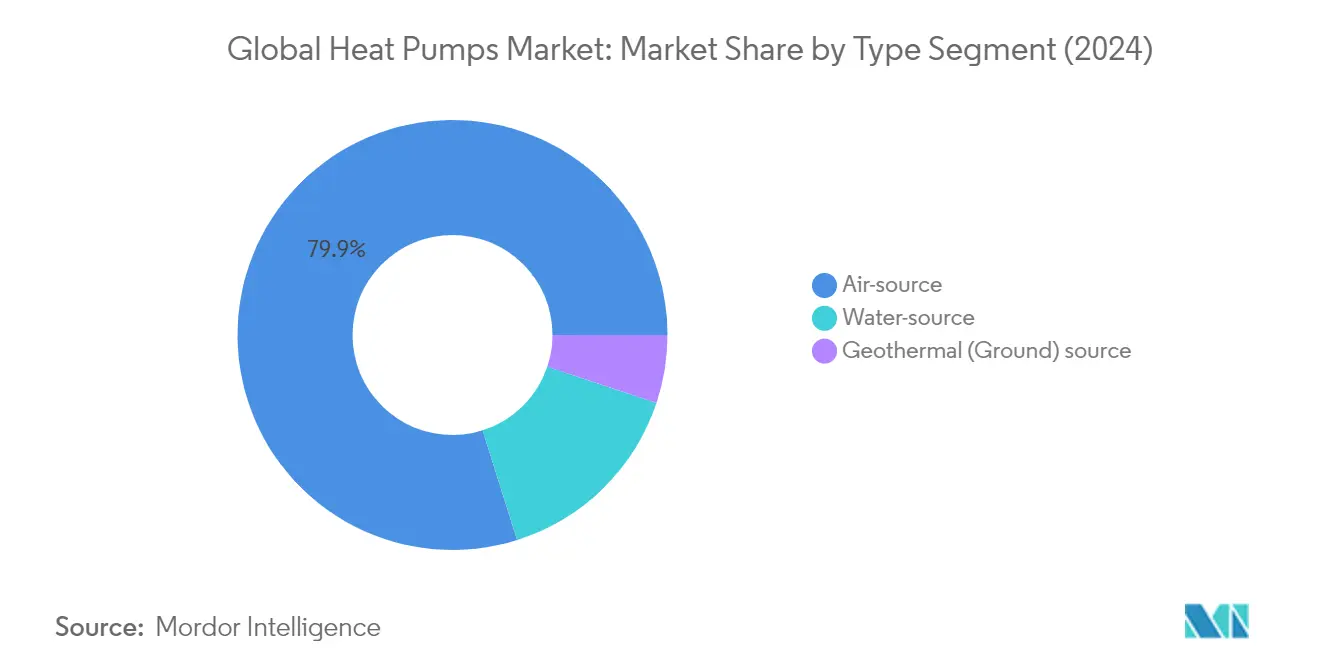
Water-source Segment in Global Heat Pumps Market
The water-source segment represents a significant opportunity in the heat pump market, offering superior efficiency compared to air-source systems. These systems can achieve remarkably high efficiencies of up to 600% by extracting heat from water sources such as lakes, ponds, rivers, springs, wells, or boreholes. The technology's appeal lies in its quieter operation and smaller system footprint, as water is more efficient at carrying away heat than air. Water-source heat pumps are particularly well-suited for commercial and industrial applications, including hospitals, pharmaceutical facilities, dairy equipment sterilization, and various manufacturing processes. The segment's growth is driven by increasing awareness of its benefits in terms of CO₂ reduction and energy savings, particularly in large-scale developments and district heating applications.
Remaining Segments in Heat Pumps Market by Type
The geothermal (ground) source segment, while smaller in market share, plays a crucial role in the heat pump market by offering consistent year-round heating and cooling capabilities. These systems leverage the stable underground temperatures to provide highly efficient heating and cooling solutions for various applications. Geothermal heat pumps are particularly valued in institutional settings such as schools, universities, and government buildings, where their long-term cost savings and environmental benefits justify the higher initial investment. The segment continues to benefit from technological advancements and increasing support from environmental policies aimed at reducing carbon emissions in both commercial and residential applications.
Segment Analysis: By End-User Vertical
Residential Segment in Global Heat Pumps Market
The residential segment dominates the global heat pump market, commanding approximately 77% market share in 2024, equivalent to USD 58,881.6 million. This significant market position is driven by increasing adoption of heat pumps in residential buildings as homeowners seek more energy-efficient and sustainable heating solutions. The segment's growth is further supported by various government initiatives and subsidies promoting the installation of heat pumps in homes, particularly in regions like Europe and North America. The residential sector's dominance is also attributed to the rising awareness about carbon emissions reduction in household heating systems and the increasing focus on residential decarbonization goals. Additionally, the development of advanced heat pump technologies specifically designed for residential applications, including air-source and ground-source systems, has made these solutions more attractive to homeowners looking to reduce their energy costs and environmental impact.
Institutional Segment in Global Heat Pumps Market
The institutional segment in the heat pump market demonstrates strong growth potential, driven by increasing adoption in facilities such as schools, hospitals, and government buildings. The segment's expansion is supported by the growing emphasis on energy-efficient heating and cooling solutions in public buildings and educational institutions. Healthcare facilities, in particular, are increasingly implementing heat pump systems to maintain precise temperature control while reducing operational costs. The institutional sector's growth is further bolstered by government policies promoting green building initiatives and sustainable energy solutions in public infrastructure. Universities and research institutions are also contributing to this growth by implementing large-scale geothermal and water-source heat pump systems as part of their sustainability commitments.
Remaining Segments in End-User Vertical
The commercial and industrial heat pumps market segments represent significant opportunities in the heat pump market, each serving distinct needs and applications. The commercial segment is driven by the adoption of heat pumps in office buildings, retail spaces, and hospitality sectors, where energy efficiency and operational cost reduction are primary concerns. Hotels and shopping centers are increasingly implementing heat pump systems as part of their sustainability initiatives. The industrial segment, while smaller in market share, plays a crucial role in specialized applications such as process heating, manufacturing facilities, and industrial space conditioning. These segments benefit from technological advancements in heat pump systems that can deliver higher temperatures and greater efficiency for specific commercial and industrial applications.
Global Heat Pumps Market Geography Segment Analysis
Heat Pumps Market in North America
North America represents a significant heat pump market, driven by an increasing focus on energy efficiency and government initiatives promoting sustainable heating solutions. The region's market is characterized by strong technological advancements in heat pump systems, particularly for cold climate applications. Both the United States and Canada are witnessing substantial growth in heat pump adoption, supported by various federal and state-level incentives aimed at reducing carbon emissions from residential and commercial heating systems.
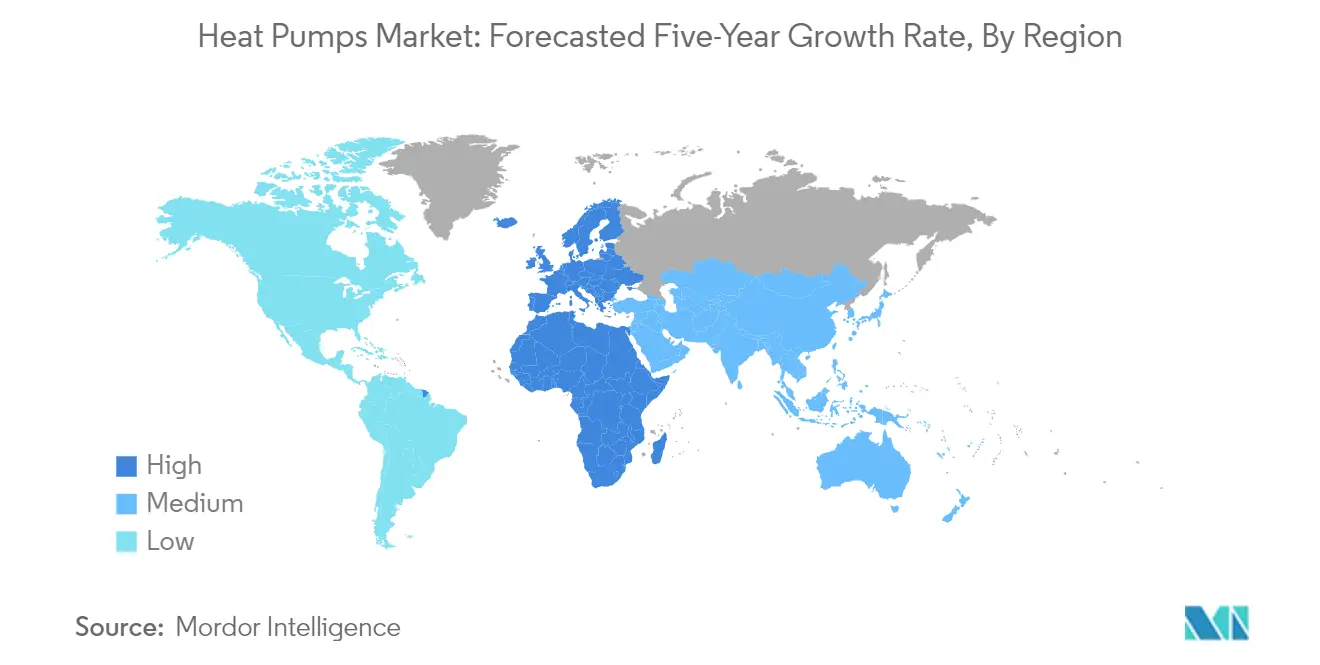
Heat Pumps Market in United States
The United States dominates the North American heat pump market, holding approximately 84% share of the regional market in 2024. The country's market is driven by the increasing deployment of heat pumps in both residential and commercial sectors. The Department of Energy's support for cold climate heat pump development, coupled with various state-level initiatives promoting the electrification of heating systems, has created a favorable environment for market growth. The country has also seen significant innovations in heat pump technology, particularly in developing systems that can operate efficiently in colder climates.
Heat Pumps Market in Canada
Canada emerges as the fastest-growing market in North America, with a projected growth rate of approximately 10% during 2024-2029. The country's aggressive stance on reducing carbon emissions and transitioning away from traditional heating systems has been a key growth driver. The Canadian government's initiatives to provide incentives for switching from oil to electric heat pumps have significantly boosted market growth. The country's cold climate has also spurred innovations in heat pump technology specifically designed for extreme weather conditions.
Heat Pumps Market in Europe
Europe represents a rapidly evolving market for heat pumps, driven by stringent environmental regulations and the region's push towards energy independence. Countries like France, Germany, Spain, Italy, and the Netherlands are at the forefront of heat pump adoption, with each nation implementing specific policies and incentives to promote the technology. The European Union's REPowerEU plan has significantly accelerated the adoption of heat pumps across the region, particularly in response to energy security concerns.
Heat Pumps Market in France
France leads the European heat pump market, commanding approximately 19% of the regional market in 2024. The country's leadership position is strengthened by its aggressive policies to phase out fossil fuel-based heating systems and increase support for renewable heating solutions. The French government's initiatives to eliminate gas subsidies and redirect funding towards renewable energy heating have created a strong foundation for market growth.
Heat Pumps Market in Netherlands
The Netherlands demonstrates the highest growth potential in Europe, with a projected growth rate of approximately 12% during 2024-2029. The country's ambitious plans to phase out natural gas in heating by 2050 have created a strong impetus for heat pump adoption. The Dutch government's mandate for hybrid heat pump systems starting in 2026, coupled with substantial subsidies for heat pump installations, has positioned the country as a key growth market in Europe.
Heat Pumps Market in Asia-Pacific
The Asia-Pacific region represents the largest market for heat pumps globally, with diverse adoption patterns across different countries. China, Japan, India, South Korea, and Australia are key markets driving regional growth. The region's market is characterized by strong manufacturing capabilities, particularly in China and Japan, along with increasing awareness about energy-efficient heating solutions. The air source heat pump market is particularly prominent in this region due to its cost-effectiveness and ease of installation.
Heat Pumps Market in China
China dominates the Asia-Pacific heat pump market, leveraging its strong manufacturing base and extensive distribution network. The country's commitment to reducing air pollution and achieving carbon neutrality has driven significant investments in heat pump technology. The Chinese government's initiatives to promote clean heating solutions, particularly in northern regions traditionally dependent on coal heating, have created substantial market opportunities. The geothermal heat pump market is also gaining traction, supported by government incentives.
Heat Pumps Market in Australia
Australia emerges as the fastest-growing market in the Asia-Pacific region, driven by an increasing focus on sustainable building solutions and government initiatives supporting clean energy adoption. The country's commitment to reducing greenhouse gas emissions has led to various incentives promoting heat pump installations. The commercial and residential sectors are both showing strong adoption trends, particularly in applications combining solar PV systems with heat pumps. The commercial heat pump market is expanding rapidly, driven by demand in large-scale applications.
Heat Pumps Market in Rest of the World
The Rest of the World region, encompassing Latin America and the Middle East & Africa, represents an emerging market for heat pumps with growing potential. In Latin America, Brazil leads the market with significant growth potential, driven by increasing construction activities and energy efficiency regulations. The Middle East & Africa region shows promising growth opportunities, particularly in commercial and industrial applications, with the UAE emerging as a key market due to its green building initiatives and sustainable development goals. The ground source heat pump market is also seeing increased interest in these regions due to its efficiency and long-term cost benefits.
Heat Pump Industry Overview
Top Companies in Heat Pumps Market
The global heat pump market is characterized by continuous product innovation and technological advancement from leading players like Daikin, Mitsubishi Electric, NIBE Group, and Viessmann. Companies are heavily investing in research and development to create more energy-efficient and environmentally friendly solutions, with a particular focus on smart connectivity and IoT integration. The industry has witnessed significant operational transformations as manufacturers expand their production capacities, especially in Europe, to meet the growing demand for heat pump solutions. Strategic partnerships and collaborations have become increasingly common, particularly in developing integrated heating solutions and expanding distribution networks. Geographic expansion remains a key priority, with companies establishing new manufacturing facilities and strengthening their presence in emerging markets while simultaneously consolidating their position in mature markets through enhanced service offerings and after-sales support.
Diverse Players Shape Dynamic Market Structure
The heat pump market share exhibits a mix of global conglomerates and specialized manufacturers, with large multinational corporations holding significant market share through their established brand presence and extensive distribution networks. These major players leverage their diverse product portfolios and technological capabilities to maintain their competitive edge, while regional specialists focus on developing market-specific solutions tailored to local climate conditions and regulatory requirements. The market structure is characterized by the presence of vertically integrated companies that control various aspects of the value chain, from component manufacturing to installation and service support.
The industry has witnessed considerable consolidation through strategic acquisitions and partnerships, particularly as companies seek to strengthen their technological capabilities and expand their geographic footprint. Market leaders are actively pursuing acquisitions of smaller, specialized manufacturers to enhance their product offerings and gain access to new markets or technologies. The competitive landscape is further shaped by the emergence of new entrants, particularly in regions with strong government support for heat pump adoption, though barriers to entry remain significant due to the technical expertise and capital requirements needed to compete effectively.
Innovation and Adaptability Drive Market Success
Success in the heat pump market increasingly depends on companies' ability to develop innovative solutions that address evolving customer needs while meeting stringent efficiency standards and environmental regulations. Incumbent players must focus on continuous product development, particularly in areas such as improved energy efficiency, reduced noise levels, and enhanced smart control capabilities. Building strong relationships with installers and contractors, maintaining efficient supply chains, and developing comprehensive service networks have become crucial factors for maintaining market position. Companies must also demonstrate agility in adapting to changing regulatory landscapes and shifting consumer preferences toward sustainable heating solutions.
For contenders looking to gain heat pump market share, differentiation through specialized applications or unique technological solutions offers a viable path forward. Success factors include developing cost-effective manufacturing processes, establishing reliable distribution networks, and building strong after-sales service capabilities. The market's future will be significantly influenced by regulatory policies promoting decarbonization and energy efficiency, making it essential for companies to align their strategies with these requirements. While substitution risk from traditional heating systems remains, the increasing focus on environmental sustainability and energy efficiency continues to favor heat pump adoption, though companies must carefully manage their pricing strategies and value propositions to maintain competitiveness.
Heat Pump Market Leaders
-
Trane Inc. (Trane Technologies PLC)
-
Midea Group
-
NIBE Group
-
Panasonic Corporation
-
Mitsubishi Electric Corporation
- *Disclaimer: Major Players sorted in no particular order
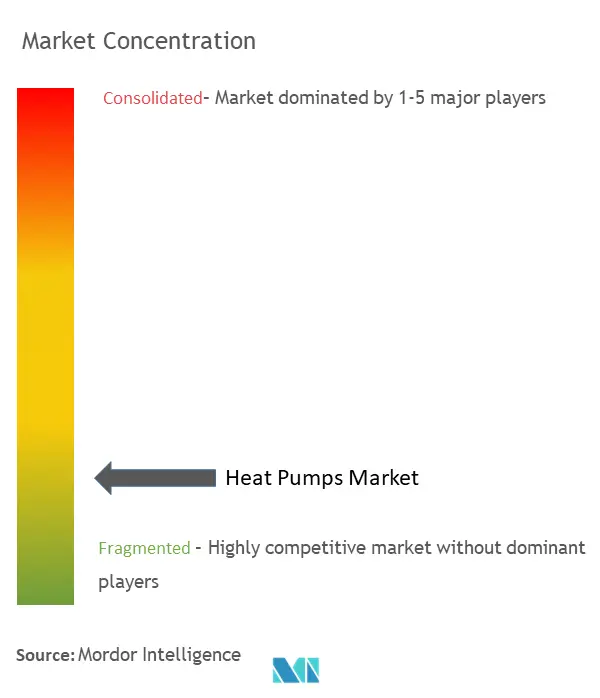
Heat Pump Market News
- January 2023 - Mitsubishi Electric US and Mitsubishi Electric Trane HVAC US LLC showcased their innovative heating technologies at the Consumer Electronics Show (CES) 2023, which took place in Las Vegas, United States. Specifically, the companies introduced their variable capacity heat pump technology, which is all-weather and energy efficient.
- October 2022 - Midea Group started constructing a new base for producing, researching, and developing heat pumps in Feltre, in northern Italy, to help facilitate its international market expansion. The new base, with an investment of EUR 60 million (USD 58.75 million), is located inside a production area of Italy's Clivet, a European company involved in the design, production, and distribution of systems for cooling, heating, air ventilation and air purification for residential, commercial and industrial markets.
Heat Pump Market Report - Table of Contents
1. INTRODUCTION
- 1.1 Study Assumptions and Market Definition
- 1.2 Scope of the Study
2. RESEARCH METHODOLOGY
3. EXECUTIVE SUMMARY
4. MARKET INSIGHTS
- 4.1 Market Overview
- 4.2 Industry Value Chain Analysis
-
4.3 Industry Attractiveness - Porter's Five Forces Analysis
- 4.3.1 Bargaining Power of Suppliers
- 4.3.2 Bargaining Power of Buyers
- 4.3.3 Threat of New Entrants
- 4.3.4 Threat of Substitute Products
- 4.3.5 Degree of Competition
- 4.4 Impact of COVID-19 on the Market
5. MARKET DYNAMICS
-
5.1 Market Drivers
- 5.1.1 Increasing Demand for Energy Efficient Solutions
- 5.1.2 Increasing Government Initiatives to Curb Carbon Emission
-
5.2 Market Restraints
- 5.2.1 High Installation Cost of Heat Pumps
6. MARKET SEGMENTATION
-
6.1 By Type
- 6.1.1 Air-Source
- 6.1.2 Water-Source
- 6.1.3 Geothermal (Ground) Source
-
6.2 By End-User Vertical
- 6.2.1 Industrial
- 6.2.2 Commercial
- 6.2.3 Institutional
- 6.2.4 Residential
-
6.3 By Geography***
- 6.3.1 North America
- 6.3.1.1 United States
- 6.3.1.2 Canada
- 6.3.2 Europe
- 6.3.2.1 Spain
- 6.3.2.2 France
- 6.3.2.3 Italy
- 6.3.2.4 Germany
- 6.3.2.5 Netherlands
- 6.3.3 Asia
- 6.3.3.1 China
- 6.3.3.2 Japan
- 6.3.3.3 India
- 6.3.3.4 South Korea
- 6.3.4 Australia and New Zealand
- 6.3.5 Latin America
- 6.3.6 Middle East and Africa
7. COMPETITIVE LANDSCAPE
-
7.1 Company Profiles*
- 7.1.1 Trane Inc. (Trane Technologies)
- 7.1.2 Midea Group
- 7.1.3 NIBE Group
- 7.1.4 Panasonic Corporation
- 7.1.5 Mitsubishi Electric Corporation
- 7.1.6 Daikin Industries Ltd
- 7.1.7 Stiebel Eltron GmbH & Co. KG (De)
- 7.1.8 Glen Dimplex Group
- 7.1.9 Viessmann Werke GmbH & Co. KG
- 7.1.10 Flamingo Heat Pumps (Flamingo Chillers)
- 7.1.11 WOLF GMBH (ARISTON GROUP)
- 7.1.12 Efficiency Maine
8. INVESTMENT ANALYSIS
9. FUTURE OF THE MARKET
Heat Pump Industry Segmentation
A heat pump is an electrically-driven device that extracts heat from a source (a low-temperature place) and delivers it to a sink (a higher-temperature place). In other words, a heat pump is a device that uses a small amount of energy to move heat from one location to another. The working of heat pumps can also be reversed to cool a building.
The Heat Pumps Market is segmented by type (air source, water source, geothermal (ground) source), by end-user vertical (industrial, commercial, institutional, residential), and geography (North America [United States, Canada], Europe [Spain, France, Italy, Germany, Netherlands], Asia Pacific [China, Japan, India, South Korea, Australia], Rest of the World [Latin America, Middle East, and Africa]). The report offers market forecasts and size in value (USD) for all the above segments.
| By Type | Air-Source | ||
| Water-Source | |||
| Geothermal (Ground) Source | |||
| By End-User Vertical | Industrial | ||
| Commercial | |||
| Institutional | |||
| Residential | |||
| By Geography*** | North America | United States | |
| Canada | |||
| Europe | Spain | ||
| France | |||
| Italy | |||
| Germany | |||
| Netherlands | |||
| Asia | China | ||
| Japan | |||
| India | |||
| South Korea | |||
| Australia and New Zealand | |||
| Latin America | |||
| Middle East and Africa | |||
Heat Pump Market Research FAQs
How big is the Global Heat Pumps Market?
The Global Heat Pumps Market size is expected to reach USD 75.44 billion in 2025 and grow at a CAGR of 9.80% to reach USD 120.40 billion by 2030.
What is the current Global Heat Pumps Market size?
In 2025, the Global Heat Pumps Market size is expected to reach USD 75.44 billion.
Who are the key players in Global Heat Pumps Market?
Trane Inc. (Trane Technologies PLC), Midea Group, NIBE Group, Panasonic Corporation and Mitsubishi Electric Corporation are the major companies operating in the Global Heat Pumps Market.
Which is the fastest growing region in Global Heat Pumps Market?
Europe is estimated to grow at the highest CAGR over the forecast period (2025-2030).
Which region has the biggest share in Global Heat Pumps Market?
In 2025, the Asia Pacific accounts for the largest market share in Global Heat Pumps Market.
What years does this Global Heat Pumps Market cover, and what was the market size in 2024?
In 2024, the Global Heat Pumps Market size was estimated at USD 68.05 billion. The report covers the Global Heat Pumps Market historical market size for years: 2019, 2020, 2021, 2022, 2023 and 2024. The report also forecasts the Global Heat Pumps Market size for years: 2025, 2026, 2027, 2028, 2029 and 2030.
Our Best Selling Reports
Global Heat Pumps Market Research
Mordor Intelligence offers comprehensive expertise in analyzing the global heat pump market. We deliver detailed insights into this rapidly evolving industry. Our extensive research covers various segments, including air source heat pumps, geothermal heat pump systems, and water source heat pump technologies. The report provides an in-depth analysis of the heat pump industry across key regions. This includes the North America residential heat pump markets and the Asia Pacific heat pump sector, with detailed coverage of commercial heat pump and industrial heat pumps applications.
This strategic report, available as an easy-to-download PDF, offers stakeholders crucial insights into heat pump market growth trends and future projections. Our analysis includes a detailed examination of heat pump market size metrics. It features comprehensive data on the biggest heat pump manufacturers and their technological innovations. The report addresses critical aspects of ground source heat pump development, reversible heat pump technologies, and emerging opportunities in the residential heat pump market. Stakeholders gain access to valuable data on market dynamics, competitive landscapes, and strategic growth opportunities. This is supported by our proven research methodology and expert analysis.




